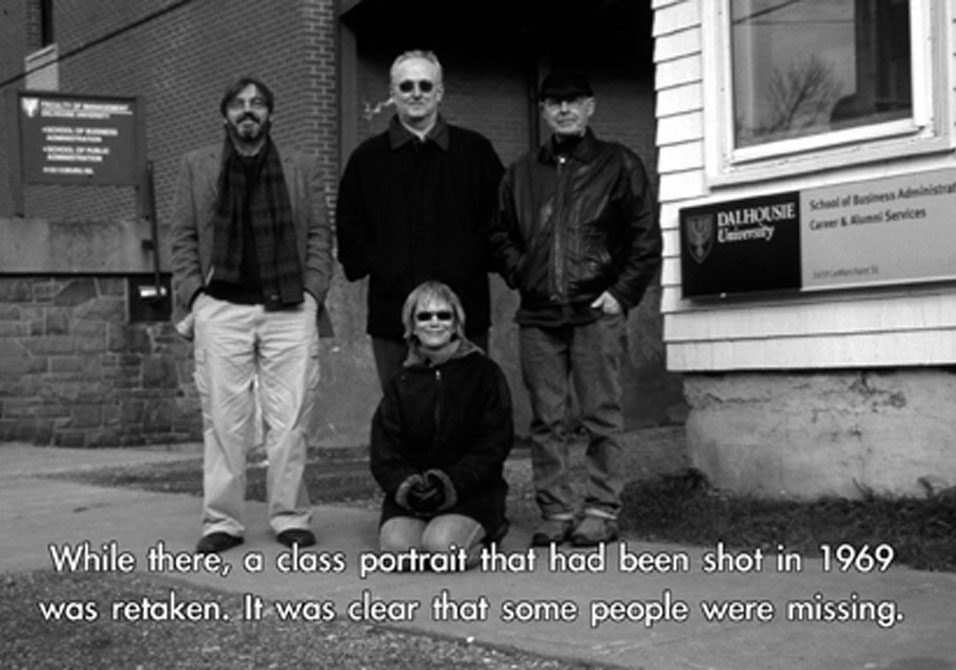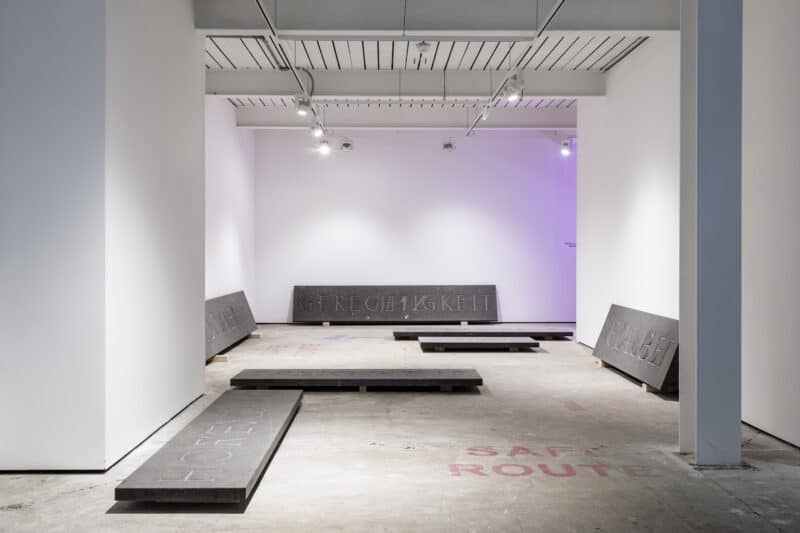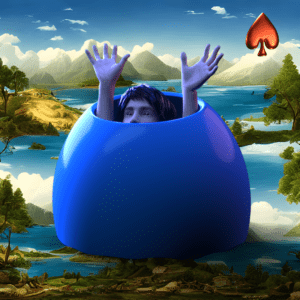
Mario Garcia Torres, What Happens in Halifax Stays in Halifax (In 36 Slides), 2004-6. Mixed media installation. Dimensions variable. Courtesy Jan Mot, Brussels.
The work of the Los Angeles-based Mexican artist, Mario Garcia Torres, investigates specific incidents and personalities from within the history of conceptual art. Through the use of video, slide installations, and photography, the artist introduces fresh perspectives on Conceptualism’s forgotten narratives. What Happens in Halifax Stays in Halifax (in 36 Slides) (2004-2006) revisits a little-known event that occurred in 1969 in a course taught by the artist David Askevold at Halifax’s NSCAD University. Askevold’s students were asked to produce a work based on an instruction provided by the artist Robert Barry, and the class was asked to decide on a shared idea that had to be kept secret. The piece would only exist for as long as the idea remained within the confines of this student group. Seeking out some of these students 35 years later and arranging their reunion, Garcia Torres documented this event and various sites in Halifax associated with the project to create a slideshow that is at once critical, playful, and nostalgic.
10 AT WATTIS
Mario Garcia Torres in conversation with Jens Hoffmann
Jens Hoffmann (JH): How did you come across the exhibition 9 at Leo Castelli? Can you tell me more about this exhibition?
Mario Garcia Torres (MGT): I knew a few things about this show that intrigued me. I knew it was a key exhibition and that, nevertheless, there was very little documentation and some accounts about it were conflicting. When I saw the Rafael Ferrer piece in Lucy Lippard’s book and learned that the work was arguably in the show, it started to intrigue me even more. I never read much about the exhibition until some months ago when I was trying to understand the context of a specific piece by Stephen Kaltenbach, which was shown in 9 at Leo Castelli and that had never been shown again until recently. I organized an exhibition in which that piece was remade, so I started to read more about 9 at Leo Castelli and became extremely interested in it, mainly in the blurriness surrounding it. I then tried to gather all the documentation I could surrounding the exhibition.
9 at Leo Castelli was organized by Robert Morris at the Castelli Warehouse—actually a storage space—in December 1968, a few months after Morris published his “Anti-Form” essay. It could be said that the text became the starting point for the exhibition, as the works shown were process-oriented and related to materials. It included the work of Kaltenbach as well as that of Giovani Anselmo, Bill Bollinger, Rafael Ferrer, Eva Hesse, Bruce Nauman, Alan Saret, Richard Serra, Keith Sonnier and Gilberto Zorio. The show was unique in several ways, one of them was the fact that a space this rough had never been used before, and it set an aesthetic of the studio as the background for showing works. Very few people actually saw the exhibition, but nevertheless it soon gained some kind of mythical status. The show is discussed and mentioned in several academic accounts but most of the information about it is still not clear.
JH: Where is your interest in revisiting art history coming from? Where do you usually start your investigations?
MGT: I am interested in these little-discussed events in history. I think some of them still have the potential to trigger questions both regarding their own nature, and regarding historiography. All my research starts from very personal interests. I guess that is why most of them have to do with art history, and within a rather tight historical timeframe.
JH: In the book we did there are eleven artists listed instead of nine, as one would imagine. Can you explain this?
MGT: Although the book we did started with the idea of making something that could become the unauthorized version of the nonexistent catalogue, it actually became more like an appendix to the few inaccurate accounts there are of the show. I realized it was more interesting to further the confusion surrounding the show than try to straighten out the information. So, besides putting the list of works together, the book only helps to understand the discrepancies and the context where the show happened. In the book, I concentrate mainly on two individuals who are listed along with the rest of the artists: Rafael Ferrer, a Puerto Rican artist who did a supposedly pre-planned impromptu intervention in the show, and Joseph Beuys, who had been invited to the show but did not accept the invitation, hence the eleven artist names.
JH: Why are you doing the exhibition now? You are re-making each of the works in the show, how will this all manifest itself?
MGT: While doing the research for the book, I very quickly realized there are only a few pictures of the show. Although it is possible to see most of the works included in the exhibition, as most have been reproduced somewhere else, I thought that it deserves to be experienced again, maybe by more people, and it deserves to be documented in a different way. So to me the show, hopefully, will have two different moments. The first is what people will see at the Wattis Institute, the other occurs when I put it back into circulation through a narrative, maybe cinematic version of it, in the exhibition’s documentation.
JH: It is almost impossible to re-do an exhibition as it was in 1968. How do you think the meaning of these works has shifted?
MGT: I really want to think of the show as a theater piece, a month long theater piece. In that sense, the information about the show as a whole and about each artwork becomes a script, and hopefully what people will see is a rather straight-forward interpretation of that. It is interesting that part of the confusion about whether some of the artists were or were not in the show (Morris himself, Zorio and Anselmo) was due to the fact that while documenting the exhibition they moved works around. Maybe they did it for aesthetic reasons, maybe because there wasn’t enough space (as is the case at the Wattis too), or maybe because some of the artworks arrived late (which some accounts mention). The fact is that they moved things around during the weeks the show was open, thus having a different show during the time it was up, which is also coherent with the nature of the works. Actually Kaltenbach’s felt piece was supposed to be re-arranged on a daily basis, but it wasn’t. I am hoping this time it will be. On the other hand, it is interesting to think that even though the list of artists and works was decided by Morris, it is uncertain if he actually decided on the installation dynamic or design.
At the Wattis, the gallery space will become not only a stage but also a workshop where works are made, installed, uninstalled and disassembled. The materials for all the works will remain in the space, but not all the works will always be on display, thus becoming a piece about process and materials. It is something like a rehearsal for the show that happened in 1968.
JH: How do you see the show in relation to the book?
MGT: I am re-making a show but, at the same time, it feels like I am undoing it. I am taking things in reverse by doing a catalogue first and the show afterwards. I like this relationship. It’s as if the work is never finished, as they never really correspond with each other. The documentation of an event is never its objective registration but maybe a parallel narrative, which is something I have been generally interested in for a while, as a take on historiography.
JH: Do you want to say what the images are that illustrate this interview?
MGT: They are pictures of the space where 9 at Leo Castelli happened, as it looked a few months ago. I went to New York and looked at the space and took these images.
CCA Wattis Institute for Contemporary Arts Via (ARTDaily)









